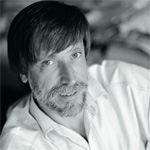Looking at the heavens
Alvaro De Rújula is a theoretical physicist at CERN, whose research interests include astrophysics and cosmology.
 “The founders of CERN found it appropriate to cite ‘cosmic rays’ as one of the research items of the Laboratory. That is hardly surprising: cosmic rays, discovered in 1912, are the first item of ‘particle astrophysics’. To date, their origin is not understood. Many unstable particles were first discovered in cosmic rays, well before they could be artificially produced. If CERN were to be refounded — or refunded — there is no question that cosmology would be a key research item as well.
“The founders of CERN found it appropriate to cite ‘cosmic rays’ as one of the research items of the Laboratory. That is hardly surprising: cosmic rays, discovered in 1912, are the first item of ‘particle astrophysics’. To date, their origin is not understood. Many unstable particles were first discovered in cosmic rays, well before they could be artificially produced. If CERN were to be refounded — or refunded — there is no question that cosmology would be a key research item as well.
Cosmic rays have even contributed to saving CERN (and the Brookhaven lab) from being viewed as ‘labs of mass destruction’. There was a perceived threat that heavy-ion collisions would produce strange nuclei or mini-black-holes, which might literally eat up our whole planet. The fact that such events do not seem to take place in cosmic-ray collisions with other cosmic rays, or with the Moon, was among the arguments that defused the impact of this threat.
CERN’s direct involvement in astrophysics and cosmology is weaker than that of our sister labs in the United States, SLAC and Fermilab, yet, it is far from negligible. For years, CERN has hosted one of the two gravitational-wave antennas of the Rome group, designed to discover these waves directly and to study processes such as the coalescence of neutron stars or the birth of black holes. If successful, this kind of experiment would inaugurate ‘a new way of looking at the heavens’.
There are other CERN experiments in astrophysics, such as CAST, in which an LHC magnet is used to search for hypothetical but theoretically ‘needed’ particles called axions, by converting the ones that the Sun would emit into electromagnetic signals. Axions and massive neutrinos could play a role in cosmology, and experiments at CERN’s ISOLDE facility have not only directly searched for axions, but have provided the best direct upper limits on the mass of the electron neutrino (as opposed to the corresponding antineutrino).
CERN also ‘recognizes’ other astrophysical endeavours: it gives them modest support and a local address. One is AMS, an orbital detector designed to study matter and antimatter in cosmic rays, as well as the putative effects of dark matter in our Galaxy. Among various others, Nestor and Antares, large sea water detectors of high-energy cosmic-ray neutrinos, are also ‘recognized’.
The second biggest mystery of cosmology is the nature of dark matter. The most popular candidate is the ‘lightest supersymmetric particle’. It may well be that such an object is first observed at the LHC.
The most intriguing of all physical conundra is the alleged non-vanishing value of Einstein's ‘cosmological constant’, the energy density of the vacuum, which would be the gravitational source of the observed accelerated expansion of the Universe at large distances. There is another sense in which, also surprisingly, the vacuum is not ‘empty’: somewhat naively, particles are supposed to acquire their mass by interacting with the vacuum (the so-called ‘Higgs mechanism’). At CERN, an enormous amount of theoretical work and experimental-design effort have been devoted to ascertain how the LHC will thoroughly explore this mechanism, perhaps giving us the hint — concerning the nature of the vacuum — that we are obviously lacking.”

